Final report for GNC20-304
Project Information
A disconnect can exist between “expert” scientists’ and growers’ priorities, and miscommunication between these two groups can lead to a reduction in the adoption of integrated pest management (IPM) practices. However, we can improve communication between growers and scientists by understanding the drivers behind grower decision making. For many growers, these decisions can be influenced by their social networks, experience level, and crop production style (conventional versus organic).
Specialty crop growers in Indiana and Ohio have access to many IPM tools; however, growers rely heavily on insecticides to control insect pests. One unexplored IPM tool is insect-resistant crop varieties. This tool is ideal because insect-resistant varieties are compatible with many control practices and can easily be added to existing IPM plans. Carrot is an important specialty crop that could benefit from the investigation of insect-resistant varieties. Currently, growers are struggling to control the carrot weevil, a devastating pest of apiaceous crops that can cause up to 90% yield loss. Investigation of novel management strategies like insect-resistant varieties could improve the profitability and sustainability of this crop.
In this project entitled “Assessing growers’ knowledge of and interest in implementing insect-resistant varieties as a part of an integrated pest management plan,” we will use a survey to assess specialty crop growers’ knowledge of and attitudes towards insect-resistant varieties and evaluate whether these attitudes differ between conventional and organic producers and with years of farming experience. Additionally, we will assess the resistance of seven carrot varieties to carrot weevil damage through greenhouse and field trials.
The information gained from this project will help us understand the factors and potential barriers considered by growers in deciding how to approach pest management in their crops. Moving forward, this will guide members of the research, extension, and education communities in developing learning materials that address grower knowledge gaps. Furthermore, growers will be able to make informed decisions about the seed or transplant varieties they select, improving insect pest management and reducing growers’ reliance on insecticides. The success of this project will be evaluated through follow up surveys to assess the effectiveness of extension deliverables as well as documentation of engagement with and use of online materials produced from this project (i.e., number of views and downloads).
Learning outcomes:
- Growers and extension educators will be aware of the pests present in carrot fields and how these populations can change over time and between varieties.
- Growers will learn about insect-resistant varieties, and how to integrate them into their current integrated pest management plan.
- Extension educators will be aware of growers’ attitudes towards and knowledge of resistant cultivars as a management tool, and how these attitudes differ between conventional and organic growers.
Action outcomes:
- Growers will be able to make informed decisions when purchasing seeds or transplants for their local pest challenges.
- Growers will be able to incorporate resistant varieties into their current pest management plan, reducing the need for insecticide.
- Extension educators will be able to develop targeted extension material to address grower knowledge gaps and tailor the information for growers with different management strategies.
Cooperators
Research
Field Trial
To evaluate carrot weevil preference for each of the commercial carrot varieties and the occurrence of other insects on carrots in a typical farm setting, we ran a variety trial from April to July 2021 at three locations: (1) a small, organic farm in DeMotte, Indiana, (2) Meigs Purdue Agricultural Research Center in Lafayette, Indiana, and (3) The Ohio State University Muck Crops Research Station in Willard, Ohio. We planted seven commercially available varieties of carrots (Table 1) at each of the three locations following a randomized complete block design, where every carrot variety was present in every experimental plot. The field sites in Willard, Ohio and Lafayette, Indiana consisted of 30-feet-long, triple-row plots of each carrot variety (Fig. 1) replicated four times for a total of 28 experimental field plots at each site. The field site in DeMotte, Indiana was smaller and consisted of 4-feet-long, triple row plots of each carrot variety (Fig. 2), replicated three times in a single 100-foot bed for a total of 21 experimental plots. All trial locations were planted in April and seeded at a rate of 24 seeds/ft.
Once plants reached the vulnerable stage, with at least four true leaves [1], we visited each field location twice a month in June and July (Table 2) and scouted 20 plants at random in each plot for egg scars (Fig. 3) to assess carrot weevil preference for the seven carrot varieties under field conditions. To further characterize the insect communities associated with our seven carrot varieties, we also collected above-ground arthropods from the foliage of carrot plants during each site visit using a D-VAC suction sampler (Fig. 4), which vacuums insects into a mesh bag where they are captured. All insects collected were identified to taxonomic Order.
On the last collection and scouting date at each site (Table 2), we harvested 20 randomly selected carrots from each plot and weighed them. A final stand count was taken for each plot by counting the number of carrot plants present per two feet of row. Stand count and weight was used to estimate total yield. We used the 20 harvested carrots to assess root damage caused by carrot weevil larvae using a 1 to 7 rating scale, with a rating of 1 representing tunneling damage one centimeter below the crown (least amount of damage) and a rating of 7 representing tunneling damage seven centimeters below the crown (most severe damage) [2]. Finally, we collected three carrot roots from each variety at each location and submitted them for nutrient analysis, focusing specifically on nitrogen and phosphorus content, at Brookside Laboratory (New Bremmon, Ohio).
Laboratory trial
To assess adult carrot weevil egg-laying preference and survival of carrot weevil larvae in each of the seven carrot varieties in a more controlled setting, we planted seeds from each of the seven carrot varieties (Table 1) in potting soil and conducted two experiments in the laboratory: one to assess carrot weevil egg-laying choice and another to assess larval survival. These experiments were conducted in the laboratory under ambient temperature and long day light conditions (16 hours of light: 8 hours of dark).
When seedlings reached the 2-leaf stage, they were transplanted into 6.5-inch x 6.25-inch circular pots, with two plants in each pot. There were 6 replicate pots of each carrot variety for a total of 42 experimental pots. When all carrots reached the vulnerable 4-leaf stage, each pot of carrot plants was placed inside a 12-inch x 12-inch x 12-inch mesh cage and three carrot weevil mating pairs were released onto carrot plants in each cage. Over a 7-day period, we recorded the total number of egg scars on the two carrot plants of each variety in each pot.
The survival of carrot weevil larvae in each of the carrot varieties was assessed by manually placing two carrot weevil eggs into individual-potted carrot plants. One egg was placed in the crown of the carrot plant and another in the stem of the carrot plant (approximately 3 centimeters above the crown). Eggs were collected from an established carrot weevil colony in the Long Lab, sanitized in a 2% bleach solution, and placed in roughly two-millimeter-deep artificial “egg scar holes” we created using toothpicks. All plants that we artificially infested with eggs were paired with healthy plants that received artificial “egg scar holes,” but no eggs. There were 7 replicate pots of each carrot variety for a total of 49 experimental pots. Eggs were allowed to hatch, and larvae were allowed to develop for 20-28 days. At the end of the development period, carrot plants were dissected, and all surviving carrot weevil larvae were counted.
Grower Survey
To assess growers’ knowledge of vegetable varieties with resistance against insects, as well as their interest in adopting these varieties on their farms, we developed an online Qualtrics survey entitled, “Survey of Ohio and Indiana Vegetable Growers” and disseminated it to Ohio and Indiana vegetable growers via an email containing a link to the survey. We received approval from Purdue’s Institutional Review Board (IRB-2020-1461) to carry out the survey and asked 13 questions to gather key information from growers, including factors like the number of vegetable crops grown, years of experience farming, management type, and current use of integrated pest management (IPM) strategies. The survey was distributed to growers through extension educators, grower newsletters, as well as social media and was available from April 2021 to January 2022.
Statistical analysis
We compared the cumulative number of egg scars present on each of the seven varieties of carrots at the end of field and laboratory trials using non-parametric statistical tests and pairwise comparisons that were appropriate for our experimental design Similarly, we used a non-parametric statistical test and pairwise comparisons to determine if there were any differences in root damage across the seven carrot varieties at the end of the field trial. We also compared average yield (kg/100 ft) and level of nitrogen and phosphorous in roots among the seven varieties using analysis of variance. All analyses were conducted in RStudio.
|
Variety |
Market Class |
Market Class Use (Luby and Goldman 2016)1 |
Retail description |
|
1. Danvers 126 |
Danvers |
Processing |
Storage, Resistant to cracks and splits |
|
2. Resistafly |
Nantes |
Fresh market |
Storage, Resistant to carrot rust fly |
|
3. Scarlet Nantes |
Nantes |
Fresh market |
Bunching and Storage |
|
4. Red Core Chantenay |
Chantenay |
Processing |
Storage |
|
5. Cosmic Purple |
Danvers |
Processing |
Gourmet |
|
6. Yellowstone |
Nantes x Imperator |
Fresh market |
Bunching carrot |
|
7. White Satin |
Nantes |
Fresh market |
Bunching carrot |
|
1 Luby, C.H. and Goldman, I.L. (2016) Improving freedom to operate in carrot breeding through the development of eight open-source composite populations of carrot (Daucus carota L. var. sativus). Sustainability 8, 479 |
|||
|
Table 2. The location of carrot field plots and dates of carrot weevil egg scar-scouting and collection of insects in field plots using a vacuum sampler. |
|
|
Location |
Collection Date |
|
Lafayette, IN |
6-10-2021 |
|
6-29-2021 |
|
|
7-14-2021 |
|
|
7-26-2021 |
|
|
Willard, OH |
6-07-2021 |
|
6-23-2021 |
|
|
7-09-2021 |
|
|
7-28-2021 |
|
|
De Motte, IN |
6-04-2021 |
|
6-22-2021 |
|
|
7-13-2021 |
|
|
7-19-2021 |
|
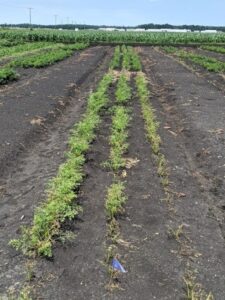
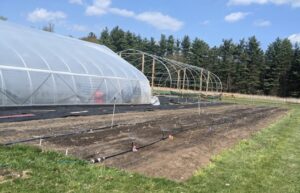
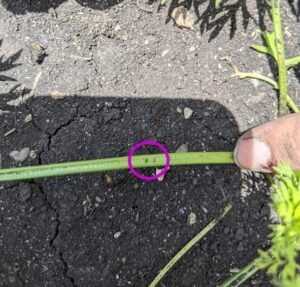
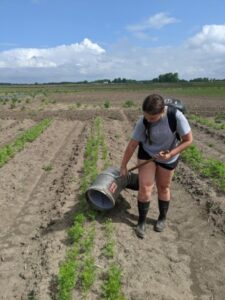
Field Trial
To assess carrot weevil preference for seven commercial carrot varieties (Table 1) we set up variety trials across three sites in Indiana and Ohio. We anticipated that carrot weevil damage would differ between locations, with the greatest pressure in Willard, Ohio where previous damage to host crops was reported to be greatest. As predicted, carrot weevil pressure was lower at both the DeMotte, IN and Lafayette, IN field locations. We observed only 21 and 33 cumulative egg scars across all carrot varieties and scouting dates at DeMotte and Lafayette, IN respectively. At the DeMotte location, carrot weevils laid the most egg scars in the White Satin variety (16 egg scars). The only other varieties that were observed to have egg scars were Resistafly (2 egg scars), Yellowstone (1 egg scar), Scarlet Nantes (1 egg scar), and Cosmic Purple (1 egg scar). At the Lafayette location, all 7 varieties had at least one egg scar recorded over the course of the season; however, the most egg scars were observed on the Cosmic Purple variety (8 egg scars). The variety with the fewest egg scars at this location was Red Core Chantenay (1 egg scar). Instances of root damage by larvae at both Indiana locations was correspondingly low. Given the limited amount of carrot weevil activity at the Indiana field sites, our results focus on egg-laying and root damage results from the Willard, OH field site.
As expected, carrot weevil pressure was higher at the Willard, Ohio field location with a total of 115 egg scars found across all 7 carrot varieties and 4 scouting dates. Of the seven carrot varieties planted, we found that Yellowstone and Cosmic Purple accumulated the most egg scars over the course of the field season with 31 egg scars observed on each variety. In contrast, Resistafly and Danvers 126 accumulated the fewest egg scars, with only six egg scars observed on each variety over the course of the season. All other varieties at the Willard, Ohio location exhibited a range of 10-17 cumulative egg scars throughout the season (Fig. 5). When comparing the number of egg scars laid on each carrot variety across time, we found no significant differences (Χ2Friedman=10.85, P < 0.09, Kendall’s coefficient= 0.06). In general, we observed a range of 1-6 egg scars in June and 1-26 egg scars in July across all 7 carrot varieties.
When evaluating tunneling damage by carrot weevil larvae at the Willard, Ohio location, we found a significant difference in severity of root damage (measured on 1-7 rating scale) across the seven carrot varieties (Χ2Kruskal-Wallis=15.96, P = 0.01). In particular, Cosmic Purple and White Satin carrot varieties exhibited significant differences in the severity of root damage. Only 2 out of 80 White Satin carrot roots exhibited tunneling damage, and the damage was not severe (damage less than 5 cm below the crown). In contrast, Cosmic Purple had nine out of 80 carrot roots with tunneling damage and six of these roots exhibited severe damage (damage greater than 5 cm below the crown) (Fig 6).
There was no significant difference in yield (Table 3) between varieties or across locations, suggesting carrot varieties performed equally well across locations. Similarly, there was no significant difference between nitrogen and phosphorous content between carrot varieties across locations. Taken together, these results suggest that the number of egg scars observed on carrot plants throughout the season may not necessarily predict the survival of carrot weevil larvae and corresponding severity of root tunneling damage. This observed mismatch in egg deposition and carrot root damage could be attributed to the presence of defensive compounds in the foliage or roots of carrot plants that alter egg-laying behavior by adult weevils, or the survival and feeding behavior of weevil larvae.
Insect communities on carrot foliage across trial locations
In total, we collected 22,668 insects from the seven carrot varieties planted across all three field sites and sampling dates. We collected the most insects at the Lafayette location (15,663 insects), followed by the Willard location (6,498 insects) and then the DeMotte location (283 insects). The low number of insects collected at DeMotte can be attributed to the smaller plot size at this location, as compared to the other field sites. Taxonomic Orders of insects containing common and occasional pests of carrot included the true bugs (Hemiptera), flies (Diptera), beetles (Coleoptera), moths and butterflies (Lepidoptera), grasshoppers (Orthoptera), and thrips (Thysanoptera) [4]. We also observed insects from Orders that include predatory insects, such as parasitoid wasps (Hymenoptera), and lacewings (Neuroptera).
True bugs were the most abundant group of insects within the pest communities observed across all three locations (Fig 7 B). This pattern was also observed across all seven carrot varieties (Fig 7 A). The Resistafly variety had the lowest number of pest insects compared to all other varieties (Fig 7 A), as well as the lowest number of carrot weevil egg scars at the Willard location, which is where carrot weevil pressure is consistently highest (Fig 5). This is particularly interesting because Resistafly was bred to be resistant to the carrot rust fly, which also lay eggs in the petiole of carrots and larvae feed on the root. Resistafly resistance to the carrot rust fly has been attributed to changes in the composition and level of volatile organic compounds in the foliage (odors that may attract or deter insects as they search for hosts), as well as the concentration of defensive compounds, like phenolics in the leaves which may deter adult feeding and egg laying. These changes in the Resistafly variety could explain the lower number of insect pests observed on the foliage, as well as the lower number of egg scars observed in our field trial.
Laboratory trials
To evaluate if carrot weevil egg-laying preference and larval survival differed significantly among the seven carrot varieties, we conducted two laboratory experiments where 1) we caged adult weevils onto carrot plants of each variety and allowed them to lay eggs, and 2) manually placed eggs into the petioles of carrot plants to see if larvae could survive. Based on results observed in our field trials, we expected carrot weevils would lay more egg scars on Cosmic Purple or Yellowstone, and fewer egg scars on Resistafly or Danvers 126. After the 1-week egg-laying period, we found that carrot weevils laid the fewest egg scars in the Red Core Chantenay variety (26 egg scars) and the most eggs in the Danvers 126 variety (62 egg scars). We did observe differences in the number of egg scars on each carrot variety; however, the differences were minor (Χ2Friedman=24.09, P < 0.0001, Kendall’s coefficient= 0.08). Specifically, Red Core Chantenay had significantly fewer egg scars (26 egg scars) than Danvers 126 (62 egg scars), Cosmic Purple (49 egg scars), and both Yellowstone and White Satin varieties (53 egg scars in each) (Fig. 8). These results differ from what we observed in the field; specifically, in the field we observed that the Danvers 126 variety accumulated the fewest egg scars at the end of the field season (Fig. 5).
When we manually placed eggs into artificial egg scars, the overall survival of carrot weevil larvae was low. Only 11% of the larvae (10 larvae) were found alive after allowing the larvae to develop for 20-28 days. All surviving larvae were found in Resistafly, Yellowstone, White Satin, Cosmic Purple, and Red Core Chantenay (Fig. 9). These results do not align with what we saw in the field; however, the artificial setting in the lab could explain the differences we observed between our field and laboratory results. For example, in the laboratory trial the physiological state of adult weevils, such as their age, mating status or availability of mature eggs, could have influenced the motivation of female weevils to lay eggs. We did confirm that the majority of eggs that were placed in carrot stems hatched and we could see signs of larval feeding and frass (insect solid waste) in the artificial egg scars. The high level of larval mortality may be explained by the differences between artificial egg scars and real egg scars made by female weevils: in natural settings, female carrot weevils cover their egg scars with an anal secretion, which may protect the fragile larvae from the external environment and desiccation.
Grower Survey
In total, 13 growers completed the survey, with 5 respondents located in Ohio and 8 in Indiana. We acknowledge that response to our survey was very low, which could bias our results, particularly in the context of trying to understand differences between groups of farmers (i.e., more experienced versus less experienced, etc.). We may have been able to increase the number of responses with a different kind of incentive, such as a gift card. Additionally, we may have been able to recruit more responses if we distributed our survey at farmers markets, grower meetings, or extension events; however, the COVID-19 pandemic precluded these options. Nevertheless, we learned from responding growers that those located in Indiana grew an average of 28 different crops, while those in Ohio grew an average of 8 different crops. Similarly, growers in Indiana grew a greater diversity of Apiaceous crops, which is the cultivated plant family that the carrot weevil damages most (Fig. 10).
We expected that growers’ knowledge of and interest in insect-resistant crop varieties would differ based on years of experience farming and management style (Conventional vs Organic). Ten respondents indicated that they use IPM strategies on their farms, which means they use a combination of management practices to reduce pest damage and limit negative environmental impacts. All responding growers reported using at least two IPM strategies, with the most common being crop rotation, followed by delayed or early planting (Fig. 11). Only five respondents indicated use of insect-resistant crop varieties as part of their IPM plan. Experienced growers (30+ years of experience) responding to our survey were less likely to be aware of insect-resistant crop varieties compared to moderately-experienced (10-29 years of experience) and new growers (0-10 years). When looking at farmers with conventional versus organic management approaches, most organic growers (six growers in total) were aware of insect-resistant crop varieties, but most were not incorporating them into their IPM strategies. Three conventional growers out of six were aware of and used insect-resistant crop varieties in their IPM strategy.
Respondents indicated that more information about the benefits of insect-resistant crop varieties would be the most helpful in informing their decision to incorporate this IPM tactic on their farms (Fig. 12). Additionally, respondents were equally interested in more information about the cost and efficacy of insect-resistant crop varieties. Growers also suggested that information about the palatability of resistant crop varieties and the mechanism of resistance would be helpful. Based on what we learned from the survey, the development and distribution of educational extension materials highlighting the results from our carrot variety field and laboratory trials should focus on new and organic farmers. Additionally, we should take care to reach growers in areas where historically, carrot weevils have been a problem.
|
Table 3. Average yield and standard error of the mean of seven carrot varieties planted in field plots at three locations in 2021. Yield is estimated from carrot harvest in 100 feet of row. |
||
|
Variety |
Location |
Yield (Kg) |
|
Resistafly |
De Motte, IN |
49.11 ± 12.79 |
|
Lafayette, IN |
53.58 ± 4.25 |
|
|
Willard, OH |
44.50 ± 4.17 |
|
|
Scarlet Nantes |
De Motte, IN |
58.41 ± 6.87 |
|
Lafayette, IN |
57.68 ± 6.96 |
|
|
Willard, OH |
46.71 ± 4.82 |
|
|
Yellowstone |
De Motte, IN |
45.42 ± 4.04 |
|
Lafayette, IN |
57.18 ± 6.48 |
|
|
Willard, OH |
47.25 ± 18.58 |
|
|
White Satin |
De Motte, IN |
70.38 ± 11.93 |
|
Lafayette, IN |
92.57 ± 13.15 |
|
|
Willard, OH |
52.38 ± 3.29 |
|
|
Cosmic Purple |
De Motte, IN |
41.52 ± 9.41 |
|
Lafayette, IN |
92.58 ± 5.77 |
|
|
Willard, OH |
52.38 ± 15.64 |
|
|
Red Core Chantenay |
De Motte, IN |
54.17 ± 1.56 |
|
Lafayette, IN |
64.77 ± 10.98 |
|
|
Willard, OH |
62.25 ± 1.55 |
|
|
Danvers 126 |
De Motte, IN |
47.92 ± 6.19 |
|
Lafayette, IN |
49.17 ± 5.34 |
|
|
Willard, OH |
44.56 ± 5.41 |
|
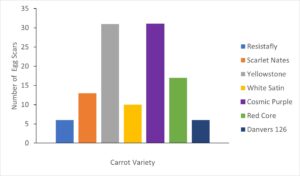
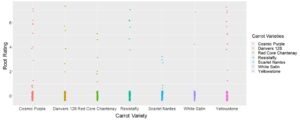
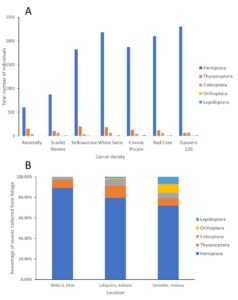
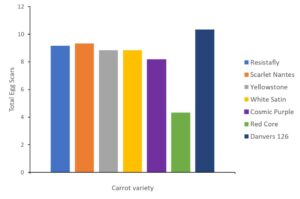
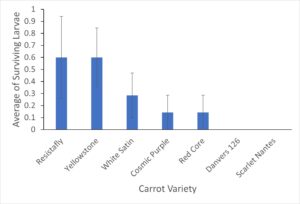
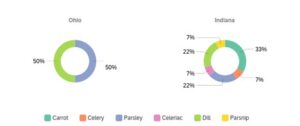
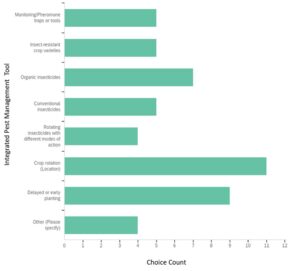
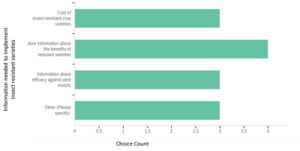
Educational & Outreach Activities
Participation Summary:
I gave a research update at Muck Crops Field Day in Willard, Ohio where growers, researchers, and industry representative meet to discuss the research activities at the Muck Crops Agricultural Research Satio.
I will publish two extension deliverables that highlight the results and practical applications that I learned from the carrot weevil-carrot variety experiments. One deliverable will focus on carrot weevil host choice and the other will focus on the insects we collected from carrot foliage. I will also submit the results of our trial to the Indiana Vegetable Variety Trials Report hosted by Purdue University. In addition, I will present results from this project at the Joint meetings of the Entomological Society of America, Entomological Society of Canada, and Entomological Society of British Columbia in Vancouver, Canada in 2022. We will also continue to identify the insects we collected to taxonomic family and highlighting key pests, parasitoids, and predatory insects that will be of interest to all vegetable growers.
Project Outcomes
The carrot weevil is evading current control measures and growers are in need of novel management strategies for this devastating pest. This project is the first investigation into carrot weevil preference for and larval survival in commercially available carrot varieties. Our results suggest that Resistafly, which was bread to be resistant to carrot rust fly, warrants a closer look at resistance to other key pests of carrot like the carrot weevil. Further development of pest-resistant carrot varieties could reduce our reliance on insecticides, resulting in cost savings for growers while maintaining profitable yields. Furthermore, a reduction in grower reliance on insecticide could result in less risk for applicators, consumers, and the environment. The incorporation of insect-resistant varieties like Resistafly could result in the increased sustainability of this intensively managed specialty crop.
Finally, our grower survey gave us some insight into the current knowledge of attitudes towards insect-resistant varieties and will help develop new extension material and target growers that could benefit from this information. Taken together, the information from this project builds a foundation for researchers to develop and educators to disseminate information about insect-resistant varieties.
Knowledge Gained: Emily Justus
Through this project I was able to interact with growers from different backgrounds and develop new skills in social science research. Until this project, the majority of my professional interactions have been with commercial growers. In my field trial a small farm, organic grower allowed us to conduct a carrot variety trial on his land. This experience opened my eyes to the needs of these growers and how different they are from those of a large scale, conventional grower. For example, the grower I worked with grew more varieties on less land and with fewer resources than growers I have worked with in the past. As an entomologist, my scientific training has largely focused on how to develop hypotheses and experiments to explore insect behavior and biology as it relates to agriculture. Through this project I took my first steps towards understanding the sociological factors that play a role in agriculture, which was both challenging and rewarding. Specifically, I have a much better understanding of how to develop and deliver a survey instrument. I also have a deeper appreciation of the challenges that social scientists must overcome in their research, such as low survey response rates. I hope to use the skills and knowledge I have gained to improve future social science research that I do, as well as the evaluation of both my extension and teaching.
Knowledge Gained: Dr. Elizabeth Long
During the course of this project, I was humbled and excited to see that growers across regions and levels of experience are supportive of novel efforts to improve management of insect pests in specialty crop production. These crops are so valuable and growers are very busy making a living, but were willing to coordinate with us and take the time to provide feedback on why “they do what they do” in the context of pest management. It was really enlightening to learn how carrot weevil preferences and damage differed between the real world and laboratory environments when the exact same carrot varieties were used and it was really interesting to learn that broader insect communities may differ in occurrence on different varieties of a crop. This information is new to us and provides an exciting future direction to pursue as we continue to help growers manage important specialty crop insect pests, like the carrot weevil.